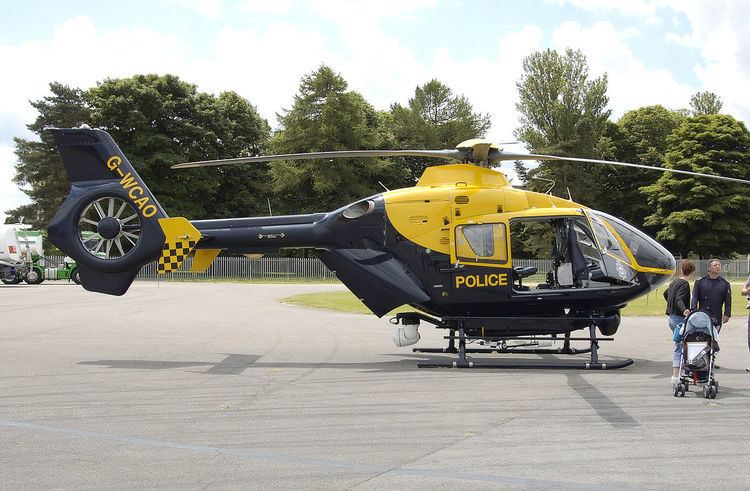 | ||
Police aviation in United Kingdom provides the British police with an aerial support unit to assist them in pursuit, surveillance and tracking. The most common air support aircraft is the Eurocopter EC 135T, which is equipped with daytime and night vision video equipment, instrument flight rules systems and radio equipment to track suspects and liaise with officers on the ground.
Contents
- History
- Operation
- Surveillance
- Drones
- Navigation
- Communication
- Incidents
- List of police aviation units
- References
While most aerial units operate helicopters, some forces also use of aeroplanes such as the Britten-Norman Defender. An aeroplane allows higher and quieter surveillance, making it less likely that suspects will become aware they are being watched. A light aircraft also allows for longer flying time and lower running costs.
Police aviation in England and Wales was once a force-by-force organisation, however from April 2012 it became centralised as a National Police Air Service.
History
In 1921, an R33 Airship was able to help the police in traffic control around the Epsom and Ascot horse-racing events.
The large mural depicting the 1936 Battle of Cable Street public order incident on the side of St. George's Town Hall in the East End of London depicts the police autogyro overhead that was present on the day.
Operation
With scramble times of just four minutes for helicopters, or with standing patrols using fixed-wing aircraft, aerial units are faster than ground units and can often be first on the scene to reported incidents.
Aerial units are often tasked to assist in vehicle pursuits. Air support allows ground units to disengage and follow from a discreet distance, hopefully making the pursuit less dangerous while still allowing ground units to be able to close in quickly as directed to apprehend suspects. Aerial surveillance also allows the police to anticipate the direction of the pursuit, and position ground units ahead of the suspect to block roads or deploy spike strips. Aerial units can also be used to efficiently locate missing persons.
Police helicopters can be crewed by three people; a civilian pilot, a police observer and rear police crew member. The pilot and observer sit up-front with eye contact with the ground. The observer is responsible for controlling the camera systems, and recording images for evidence in court. The rear police officer will assist in map-reading and strategic planning, allowing the pilot to concentrate on flying and the observer on camera control and visual reporting.
During an incident, ground and aerial units are able to communicate directly with each other, using the call sign of the unit.
Surveillance
Most police helicopters are fitted with a sphere shaped housing or pod usually under the nose of the aircraft the purpose of which is to support and stabilize two cameras using a gyroscope stabilization system. The two cameras are a standard “day camera” (a colour camera equipped with a powerful zoom lens) and a thermal imaging camera, which enables heat to be detected and is usually utilized during hours of darkness or in the search for persons in hiding. The cameras are normally connected to controls located in the cabin of the aircraft that allow the air observer to directly control them. They are also linked to a recording system and downlink system.
Force helicopters are usually equipped with a powerful “Nightsun” search light that is capable of illuminating a large area.
The Metropolitan Police Service has reportedly been secretly using Cessna aircraft for a number of years that have been fitted with surveillance equipment capable of intercepting mobile phone calls and listening-in on conversations.
Drones
In 2010, The Guardian reported police forces and government agencies across the UK are exploring the potential of unmanned drones for covert aerial surveillance, security, or emergency operations. They said at least four forces – Merseyside, Essex, Staffordshire and British Transport police – have bought or used microdrones. Microdrones can be fitted with video cameras, thermal imaging devices, radiation detectors, mobile-phone jammers and air sampling devices. Hovering at heights of around 60 metres, they are said by manufacturers to be virtually invisible from the ground. The costs of operating the drones are considerably less than operating helicopters.
Navigation
A member of the crew, usually a police constable, occupies the rear seat of the helicopter. The primary purpose of this crew member is to relay critical information to police units that are on the ground. In the case of traffic pursuits, this crew member will provide a running commentary of the exact location of the suspect's car, utilising either paper maps or a computerised mapping and navigation system.
Communication
Police helicopters are usually fitted with radios capable of transmitting and receiving communications on their force's and other force's Airwave TETRA radio system. More recently, police helicopters have been fitted with a device that allows live video images to be transmitted directly to the force command centre by way of a downlink system. Commonly fitted to the underside of the helicopter is a public address system, known as “Skyshout”.
When speaking to air traffic control police helicopters and fixed-wing aircraft use the callsign "Police" followed by a two digit number representing the police force. These numbers were originally based on a list of police forces in England & Wales in alphabetical order, followed by Northern Ireland, followed by Scotland. So "Police 01" was Avon & Somerset Police. Some police air units now cover more than one force; their number relates to one of the forces. For example, "Police 01" is now used by the "Western Counties" unit which includes the Avon & Somerset force area. If the unit has more than one aircraft a third digit will be added to identify each aircraft.
Incidents
List of police aviation units
The following is a list of police aviation units in the UK and the forces or areas to which they are assigned.
